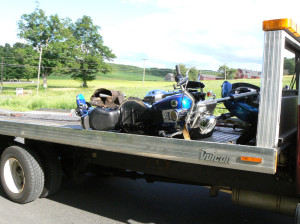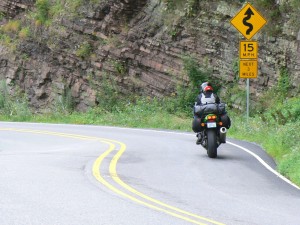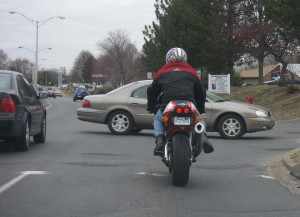
I know what you’re saying. “You’re telling me that there are only 2 things I need to do to survive riding on the street?” You betcha. So, here is the caveat to this sensational statement; there are more like 1 Gazillion things you need to know to be the safest rider you can be. But, I don’t have that much time and you’d be bored by the time I got to number 15,000. So, I’m going with my top 2.
And with no further ado, here they are. The envelope. please.
#1 Being “Speed Smart”
#2 Being Visible
Of all the things you can and should know about riding a motorcycle, these two strategies will allow you to avoid 80 to 90% of the most common situations that lead to motorcycle crashes. I hear you yelling at your laptop or smartphone saying “What about [INSERT YOUR FAVORITE STRATEGY HERE]”. I understand… really. There is way more to know to avoid becoming roadkill than just these two strategies. But, I contend that most close calls and crashes can be avoided if you follow my suggestions and focus first on these two strategies. Let me elaborate.
All photos © Ken Condon
Top Motorcycle Survival Tip #1: Be Speed Smart

Being “Speed Smart” doesn’t necessarily mean sticking to the posted speed limit. I’m no angel when it comes to ignoring ridiculous speed limit signs, especially when the payoff is worth the risk of a ticket ( a great section of twisty tarmac with little traffic). No, I’m talking about being smart about when and where you wick it up. You can avoid a majority of close calls if you just keep the throttle under control. Here’s how.
Ride at “Expected” Speeds
It’s important to ride close to the marked speed limit when riding through town centers, and whenever you are near other drivers, especially when riding through intersections. Riding at a speed that is greater than is expected will likely result in the driver pulling in front of you, thinking he or she has time to go. This is largely because a motorcycle has a narrow frontal area, which makes it more difficult for drivers to judge your approach speed and distance.
Ride Slow in a Slow Environment
One of the most common reasons motorcycle riders crash is because they ride faster than the environment will safely allow. Riding at the speed limit makes total sense when there is a lot of traffic, but what about when the road opens up? It may be tempting to go WFO, but no matter how much you wish the road were a racetrack, it is not! You can get away with excessive speed for a while, but some day it will bite you. I can almost guarantee it. Really fast sport riding belongs on a racetrack, dummy.
Even if you are a racetrack hero, you must understand that the unpredictable nature of the street does not allow you to exercise your full cornering prowess. With hazards such as road surface hazards, unexpected changes in radius and camber, or other vehicles crossing into your lane you can easily exceed the limits of the environment even though you may be nowhere near your personal limits.
Cornering Correctly: Slow in, Fast out
The vast majority of single-vehicle crashes are the result of riders failing to negotiate a curve and a common reason for this is a rider entering a corner at a speed that is too fast for the conditions or for the rider’s ability. The best strategy is to slow to a conservative speed and then gradually accelerate when you are sure it is safe to do so. Keep in mind that you can always get on the gas, but you can’t go back in time to enter the turn at a slower speed.
Respect Time and Space
Still not convinced just how significant speed is to keeping you safe? Then consider the timing and circumstances of a typical 30 mph crash. At that speed you are traveling at 44 feet per second (1 mph = 1.47 ft/sec). Getting a motorcycle stopped at 30 mph takes just over two seconds and requires about 35 feet of space. But, braking distances include more than just the time and space to physically stop your motorcycle. It also includes “thinking time” and “reaction time”. At 30 mph you can count on using about .7 seconds or 31 feet to realize that there is a problem. It then takes you another .3 seconds or 13 feet to react by rolling off the throttle and reaching for the brakes. That means you traveled 44 feet before even touching the brakes. Finally, it takes you about 2.2 seconds or 35 feet (with a typical deceleration rate achieved by the average rider) to bring the motorcycle to a halt. Add this “braking time” to the “thinking time” and “reaction time” and you’ll need a total of 3.2 seconds and 79 feet with which to stop.
Top Motorcycle Survival Tip #2: Be Visible

The most common phrase uttered by drivers who are involved in a motorcycle crash is; “I didn’t see him”. It’s easy to blame the driver for being inattentive. After all, texting, NAV systems, and other distractions are vying for drivers’ attention…you know who you are. While this is a reality on today’s roads, too many riders fail to recognize their role in being visible, choosing to wear dark colors and riding in a way that hides them from other drivers.
Even being seen is not as reliable as we would like. Most motorcyclists have stories of drivers pulling out in front of them even though the driver was looking directly at them. What would cause a driver to proceed if the rider was in plain sight? It’s common for a driver’s brain to dismiss the appearance of a relatively insignificant (small) vehicle (motorcycle) on the roadway and pull out without ever “seeing” the motorbike.
Use Effective Lane Positioning
In traffic, it’s important to constantly evaluate your ability to see and for others to see you. Poor lane position is a factor that can prevent you from being seen and seeing hazards. This includes not having sufficient following distance. Ample following distance provides a wider angle of view to see past the vehicle and allow other drivers to see you.
Proper lane positioning also includes your location within the width of your lane. Motorcycle riders have the option of riding in the left, center or right portion of the lane. This gives you the ability to place your bike where you can see farther ahead and where other drivers can see you. Exactly what is the best lane position? In many situations, riding in the left/center of your lane makes the most sense. This position allows you to see past the vehicle ahead and gives you a good angle of view of the oncoming lane. Certain situations require you to alter this position, such as an oncoming vehicle threatening to cross the centerline.
Lane position changes continually depending on the road surface, other drivers, and your angle of view.
Loud Pipes
Basic science says that sound is not a reliable source of information. Sure, loud pipes increase the likelihood that drivers will know you are in the vicinity, but don’t be fooled into thinking that sound will help a driver locate where you are in traffic. This is why installing loud pipes is not a great strategy for increasing safety.
A much more reliable strategy is to be more visible. A driver who sees you and is able to accurately judge your speed and distance is much less likely to pull out in front of you. The importance of using strategies for being seen cannot be overemphasized. Unfortunately, too many riders don’t seem to understand this.
There are lots of other tips that are important for surviving on a motorcycle like don’t ride drunk or stoned, be attentive, etc. But. if you can follow these two strategies I outlined, you are well on your way to making it home at the end of a great day of riding.
OK. Now it’s your turn.
I know you’ve been chompin’ at the bit to tell the world what you think is the most important tip for surviving. So, let’s hear your comments.

Please Donate to Keep the Articles Coming
If you liked this article and the many other articles on this site, please toss a buck or five into the hat. It’s greatly appreciated!
- Click the PayPal “Pay Now” button.
- Then indicate quantity in $2.00 increments. – Example: put “2” in “QUANTITY” field to donate $4.00, “3” for a $6.00 donation, etc.
Why $2.00? Due to the PayPal fee structure, a $2.00 donation is significantly more beneficial compared to a $1.00 donation.
Thank You!
Check out these posts:
- Product Review: TCX X-Desert Boots
- Get Anxiety & Stress Under Control (Motorcyclist)
- KLX250s Upgraded and Accessorized
- Street Triple R Gets Accessorized
- Triumph Street Triple R Review
- How To Survive Mid-Corner Hazards
- #1 Reason for Motorcycle Crashes in Corners
How Can I help You? Online Coaching NOW AVAILABLE
Stay Informed: Subscribe NOW!
 Be a Better Rider: Sign Up for Personal Training with Ken
Be a Better Rider: Sign Up for Personal Training with Ken
Support Riding in the Zone: Buy a book
Support Riding in the Zone: Buy products from Twisted Throttle & Amazon








